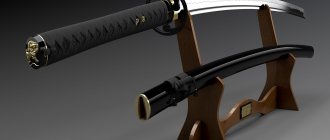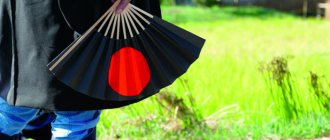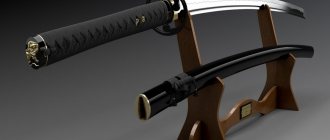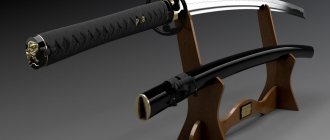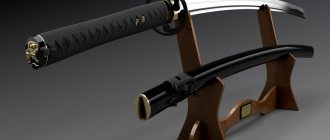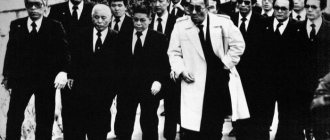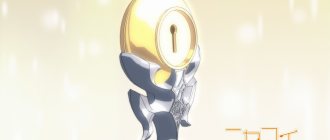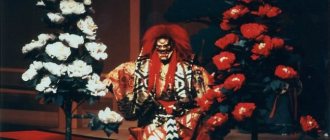History of appearance
The art of forging and processing multilayer steel appeared in Japan later than in neighboring countries, so until the 7th century, weapons were imported from China or Korea. When Japanese blacksmiths managed to master the manufacturing technique, the first Japanese swords appeared - double-edged and straight.
IX-XII centuries brought numerous internecine clashes. Samurai became an outstanding class; the sword for them acquired the status of not only a weapon, but also a symbol. The technology for manufacturing edged weapons was honed. It acquired a curved shape due to the need to conduct horse battles.
The Kamakura era, lasting from the 12th to the 14th centuries, was the heyday of the art of Japanese sword making. The samurai acquired armor, which brought new requirements for weapons. The swords acquired greater striking power, and their shape changed slightly. Now they were used mainly for foot battles, so they needed to be held with both hands. It was a time of experimentation; many blacksmiths came up with unique manufacturing technologies that have not survived to this day.
From the 14th to the 16th centuries (Muromachi period), numerous wars were fought, requiring different weapons. Therefore, new types of samurai swords appeared. But the deplorable financial situation in which many clans found themselves did not allow them to pay big money for this. Therefore, the quality of bladed weapons has dropped significantly.
In the 16th century (Momoyama era), short swords appeared. Samurai began to carry a pair of daisho (large-small) weapons. These are katana and wakizashi. Due to its size, the first was more often used outdoors or in large rooms, the second - in cramped spaces. However, the need for weapons has generally decreased as civil strife has subsided. Now wearing swords has become just a sign of status, part of the traditional costume. Therefore, weapons began to be decorated in various ways, which often affected their fighting qualities. This period was also called the Age of New Swords.
And from the second half of the 19th century, the Age of modern swords began. The weapons of this period were called gendai. Carrying swords became prohibited, which led to a decline in production. At the beginning of the 20th century, measures began to revive the country's cultural heritage, an integral part of which is the Japanese sword. And today it is a symbol, the making of which is a real art.
Murder at a Crossroads
The quality of the blade and the skill of the samurai were usually tested in battle. A good sword could cut three corpses laid on top of each other. It was believed that new samurai swords should be tested on humans. Tsuji-giri (killing at the crossroads) is the name of the ritual of testing a new sword. The victims of the samurai were beggars, peasants, travelers and just passers-by, whose number soon numbered in the thousands. The authorities posted patrols and guards on the streets, but the guards did not perform their duties well.
Samurai, who did not want to kill innocents, preferred another method - tameshi-giri. By paying the executioner, one could give him the blade that he used during the execution of the condemned man.
Advantages and disadvantages
There are many myths and legends associated with the samurai sword. The katana is credited with almost fantastic properties—cutting stones and centuries-old trees with one blow. In fact, this is an ordinary high-quality edged weapon. It has a number of advantages:
- lightness combined with strength and flexibility;
- comfortable curved shape;
- Can be used as a one- or two-handed weapon;
- good pair work - long plus short samurai sword;
- optimal characteristics for delivering fast cutting blows.
Such weapons also have disadvantages:
- complexity and duration of production;
- vulnerability to impacts from hard objects;
- formation of chips and cracks as a result of errors during use.
It should be understood that any weapon can exhibit many shortcomings in inept hands. And, conversely, mastery of the weapon makes it perfect. Samurai learned the art of wielding a katana from childhood, which is why the Japanese sword is credited with such magical abilities.
Lightness meets strength
Convenient form
Optimal combat characteristics
Nice pair work - long plus short samurai swords
Nodachi
The name literally means field sword. Nodachi, like odachi, had enormous length. Because of her, creation was difficult. The sword was worn on the back, since this was the only way possible. Nodachi did not become widespread precisely due to the complexity of its manufacture. In addition, it also required skill when fighting. The complex handling technique was due to its large size and enormous weight. It was almost impossible to snatch a sword from behind your back in the heat of battle. But where then was it used?
Perhaps the best use was fighting horsemen. The large length and sharp end made it possible to use the nodachi as a spear, which could hit both humans and horses. The sword was also quite effective when dealing damage to several targets at once. But nodachi is completely unsuitable for close combat. Samurai, if necessary, threw away the sword and picked up a more convenient katana or tachi.
Varieties
There are different types of Japanese swords. Despite the common features inherent in all varieties, they differ in size, appearance, purpose and combat characteristics. Connoisseurs of collectibles need to know all these nuances.
Katana
The most famous version of the Japanese long sword. Blade length is 60–75 cm. The shape is slightly curved. Usually a katana is made from two different alloys. The softer one is for the core of the blade, the harder one is for the outer part. This makes the structure simultaneously rigid, sharp, but flexible.
The blade is sharpened on one side. There are no strict standards for thickness, cross-section, or bending. Therefore, the weight of the weapon also varies - from 0.7 to 1 kg on average. Depending on its design, a katana is more suitable for fighting an enemy with or without armor, as a one-handed or two-handed sword, and so on. The handle is simple in shape for a comfortable position in the hand.
Tanto
This is a small dagger with a blade length of up to 30 cm. It was not usually used in battle. It was used for finishing moves, cutting off the head of an enemy who admitted defeat, and also for committing hara-kiri. Most often it is a single-edged knife, less often it is double-edged, with a removable handle.
Wakizashi
A short samurai sword, usually worn in conjunction with a katana on the belt. The length of the blade varied from 30 to 60 cm. Externally, this weapon looks like a smaller copy of a katana. Slightly curved blade, sharpened on one side, classic handle.
In battle, the time for a short sword came when it was impossible to use a katana for some reason. And sometimes they fencing with them at the same time. While a large sword was worn only by samurai, a small sword could be worn by artisans and merchants for self-defense.
Ninja
This is the name of a ninja sword, which is designed for both cutting and piercing blows. It is made much simpler than a katana. Most often the size is slightly smaller than the latter. However, there were many shapes and sizes of these weapons. He was often disguised as a wakizashi to lull the enemy's vigilance. Sometimes ninjas were reforged from captured samurai weapons.
Tati
This is the name of a samurai long sword (blade 70–90 cm). It is a two-handed curved saber. It was used exclusively as part of military armor and was worn suspended from the belt. Whereas the katana was more often tucked into the belt and worn in everyday life. A tanto was worn in tandem with this sword.
Kodachi literally means “little tachi.” Similar to wakizashi in length and technique of use, but somewhat wider. It was used as an independent weapon, and not in tandem with something.
Another variety is odachi. A long sword with a blade over 90 cm. It was used as a military weapon or for ritual purposes, as a symbol. This sword required particularly careful manufacturing technology. Due to its size, it was worn either behind the back or simply in the hand.
Tsurugi
A straight Japanese sword, sharpened on both sides of the blade. It was used as a weapon until the 10th century. With the advent of tati, it began to be used exclusively for religious purposes - for ceremonies.
Naginata
A large Japanese sword of unusual design. Its peculiarity is a very long handle - about 2 m, which is paired with a blade of 30–50 cm. Over time, shorter, lighter versions appeared. They were used not only by men in battle, but also by women in home defense.
Gong-to
Modern swords made by industrial methods. They are similar in shape and appearance to tati. In the first half of the 20th century (in particular during the Second World War), they were made to raise morale in the army and revive traditions.
Bokken
These are wooden models replicating different types of Japanese combat swords. They are made from hard wood, often varnished and decorated. Used for training and practicing combat skills in Aikido.
Kai-gunto
Literally this name translates as “sea military sword.” They were introduced on the eve of World War II as weapons for officers of the Imperial Navy. Such a sword always differed from ordinary gunas in its wooden scabbard and certain features in the finishing of the handle. In other respects, he also practically copied Tati.
Odachi
In addition to the above types of long sword, there were less known and widespread ones. One of these is odachi. The term is often confused with nodachi, which is described below, but these are two different swords.
Literally, odachi translates as “big sword.” Indeed, the length of its blade exceeds 90.9 cm. However, there is no exact definition, which is also observed with other species. In fact, every sword exceeding the above value can be called an odachi. The length is about 1.6 m, although it often exceeds it; the hilt of the Japanese sword was considerable.
Swords have not been used since the Osaka-Natsuno-Jin War of 1615. After it, a special law was issued prohibiting the use of bladed weapons of a certain length. Unfortunately, only a tiny amount of odachi survives today. The reason for this is that the owners cut off their own bladed weapons in order to comply with the standards. After the ban, swords were used as gifts, as they were quite valuable. This became their purpose. The high cost was explained by the fact that manufacturing was extremely complex.
Materials and manufacturing technology
The traditional technology of making a Japanese sword had many not only production, but also ritual aspects. Therefore, work on one subject took several months. The blacksmith began with spiritual preparation, fasted, prayed, and meditated. While working on the sword, special ritual clothing was often worn.
Currently, the Japanese have only technology left from tradition. The weapon manufacturing process includes the following steps:
- cleaning steel pieces from slag by soaking followed by remelting;
- creating multilayer metal by repeated folding and flattening;
- arrangement of several metals - for example, soft for the middle with hard for the outer shell;
- giving a basic shape;
- hardening;
- sharpening and polishing.
After the blade, the manufacture of the handle begins. It consists of several mandatory design elements. The primary covering is made from the skin of a stingray or other sea animal. The final covering is braided with leather or silk braid. Modern manufacturers often use artificial silk. Plus - a variety of decor.
The combination of hard and soft metals in the design of the katana could have different variationsToday, the samurai saber is a tribute to history, part of a traditional costume, decor, a ritual object, and not a military weapon. Therefore, much attention is paid to decoration to the detriment of combat characteristics. The handle and scabbard are carefully decorated. The blade is often engraved.
Blade components
Handle elements
What is the secret of the sharpness of the katana?
A real katana sword can sharpen itself as a result of the ordered movement of molecules. Simply by placing the blade on a special stand, the warrior would again receive a sharp blade after a certain period of time. The sword was polished in stages, using ten grinding wheels to reduce the grit. Then the master polished the blade with charcoal dust.
At the last stage, the sword was hardened in liquid clay; as a result of this procedure, a matte, thin strip (yakiba) appeared on the blade. Famous masters left their signature on the tail of the blade. After forging and hardening, the sword was polished for half a month. When the katana had a mirror shine, the work was considered completed.
Differences in combat characteristics from European models
The Japanese sword differs from its European counterparts mainly in its shape and manufacturing traditions. In terms of quality and combat characteristics, weapons of the same era were similar. And often Japanese swords were inferior to European ones. In Europe, weapons craftsmanship developed earlier and more intensively; earlier they learned how to clean metal from impurities. Therefore, the quality of swords was often a step higher.
However, there were differences in purpose. If we compare the katana with the European bastard sword, which is similar in size, then the first one dealt quick cutting blows, the second - chopping blows. For a samurai, much depended on the speed of inflicting damage on the enemy, on the skill of combining a katana with other types of weapons - a knife, a bow, and so on.
For samurai, wielding weapons was an art, so even with lower or similar quality swords, they were often more effective in battle than European warriors.
The attitude towards weapons was also fundamentally different. Among the Japanese, unlike the Europeans, it was reverent; the sword was considered almost a living creature, a continuation of its owner. The weapon was passed down from generation to generation, and many traditions were associated with it. And even now, no matter how much time has passed since the bloody wars, weapons are given great importance in Japan. This culture finds echoes in many martial arts that are popular throughout the world today.
Example of a European sword
Japanese katana
Notes
- Literally “blade” - hence the use of the Chinese character “dao” with the same meaning. The word itself was borrowed from Korea along with weapons.
- GOST R 51215-98. The weapon is cold. Terms and Definitions. B.Z. Sabers. B.3.5. katana (give): Japanese large two-handed saber with a blade over 60 cm long.
- The famous hakama pants were necessary clothing for riding through the bushes of the spring bushes.
- Evidence of this is the official genealogies of the old Japanese aristocracy, their burial mounds with Korean paintings, grave goods and burial practices, Koreanisms in Japanese military and state terminology, and much more.
- The handle was made of wood and wrapped with fabric tape; it was a consumable item and did not last long. It did not break immediately, because at the junction of the blade with it there was a coupling, usually made of soft bronze or brass, and upon impact, almost all the energy was extinguished without being transferred to the handle.
| [ + ] Katana. And cold weapons warm the soul. | |||||||||||||||||||||||
| |||||||||||||||||||||||
| [ + ] Katana is related to the land of the rising sun, desu! | |||||||||||||||
| |||||||||||||||
View
Real Japanese swords must have not only a sharp blade and strength, but also durability. They should not break under strong impacts, and can also last for a long time without sharpening. Carbon gives hardness, but at the same time the sword loses its elasticity, which means it becomes brittle. Blacksmiths in Japan invented various forms that could provide both elasticity and durability.
Ultimately it was decided that layering would solve the problem. The traditional technique involves making the core of the blade from low-carbon steel. The remaining layers are elastic. Various combinations and methods help to create such a Japanese sword. A combat blade should be convenient for a certain warrior. The blacksmith can also change the type of steel, which greatly affects the entire sword. In general, katanas can differ greatly from each other due to the reasons described above.
Due to the complexity of manufacturing, blade designs cost differently. For example, the cheapest one involves the use of one type of steel. Typically used to create tanto. But the soshu kitae is the most complex structure; it has seven layers of steel. An exemplary work created using it is a work of art. One of the first to use soshu kitae was the blacksmith Masamune.
Interesting points
In Europe and Russia it is believed that the katana is a long sword, but this is not entirely true. It really has been like this for a long time, but its use is a matter of taste. Interestingly, in Japan, the use of daisho was strictly enforced only by samurai. Military leaders and shoguns sacredly revered this rule and issued corresponding decrees. The samurai themselves treated weapons with special reverence; they kept them close to them even while sleeping. The long sword was removed at the entrance to the house, and the short sword was always with you.
Other classes of society did not have the right to use daisho, but could take them individually. A bunch of swords was the main part of a samurai's costume. It was she who confirmed the class affiliation. From an early age, warriors were taught to take care of their master's weapons.
The Legend of the Blacksmith Amakuni
Another legend concerns the appearance of the katana itself. According to legends, once upon a time, namely around the year 700, the blacksmith Amakuni lived in the province of Yamato, and with him his family. Standing outside his workshop, instead of working in it, he watched the soldiers of the imperial army.
And then the brightest man passed by them, but for some reason he did not say a word in favor of the weapons created by the blacksmiths
Then Amakuni drew attention to the warriors’ weapons. It turned out that many swords could not withstand the heat of the battle and were broken
After this, it became clear why the emperor did not want to talk to the blacksmith. However, he, apparently, was very humane, because for such a blacksmith could say goodbye to his head.
Like a true master, Amakuni decided to improve and make a weapon that would be very difficult to break. He, first of all, took those blades that survived the battle and began to carefully examine them. He found out that many of the intact swords had high-quality material and hardening. After all this, he and his son prayed to the Shinto gods for seven days.
But only then did they come to their senses and decide to work. And after 15 days of persistent trial and error, the blacksmiths appeared with strange swords with a curved shape and a sharp edge on one side. Then everyone thought that Amakuni had gone crazy. But spring came, and with it another war. And so the emperor, when returning from the battle, exclaimed towards the blacksmith: “Amakuni, you are a real master in making swords. Not a single sword of yours was broken in this battle."
This is the legend that the blacksmiths from the Yamato province will tell you. Probably every prefecture will tell this legend, but in their version, Amakuni will live here.
Bloodthirsty Blades of Muramasa
Muramasa was a famous Japanese swordsman and blacksmith who lived in the 16th century.
According to legend, Muramasa prayed to the gods to imbue his blades with bloodthirstiness and destructive power. The master made very good swords, and the gods respected his request, placing a demonic spirit of extermination of all living things in each blade. It is believed that if the Muramasa sword gathers dust for a long time without use, it can provoke the owner to commit murder or suicide in order to “drink” blood in this way. There are countless stories of Muramasa sword wielders who went crazy or slaughtered many people. After a series of accidents and murders that occurred in the family of the famous shogun Tokugawa Ieyasu, which popular rumor associated with Muramasa's curse, the government outlawed the master's blades, and most of them were destroyed.
To be fair, it must be said that the Muramasa school is an entire dynasty of gunsmiths that lasted for about a century, so the story of the “demonic spirit of bloodthirstiness” embedded in swords is nothing more than a legend. The curse of the blades made by the masters of the school was, paradoxically as it may sound, their exceptional quality. Many experienced warriors preferred them to other swords and, apparently, thanks to their art and the sharpness of Muramasa’s blades, they won victories more often than others.
Instead of an afterword
Throughout the history of mankind, a knife has remained primarily a convenient, functional item for everyday life, war, hunting and survival. Its shape and technology have been improved to achieve maximum comfort and durability. As for the tanto knife, its main task is to be sold. Therefore, in its history, mainly marketing tools were developed to promote this miracle to the American market. Of course, it can be purchased as a souvenir blade, but as a knife for any practical use it is an extremely dubious idea.
And a little more about the American tanto knife:
Features of a real samurai sword
You cannot buy a real samurai sword at the nearest weapons store, although, of course, there are good combat models there, but they are very far from the true weapons of the samurai. Moreover, you will not be able to purchase them in souvenir shops that actively like to sell stylized Chinese consumer goods. And the main problem is the financial situation of each of us, and not at all the geography of blade production. Just one blade can cost as much as a pair of full-fledged A-Class Mercedes, and this is provided that you bargain with the master.
There are four features that distinguish a samurai sword from all others:
- Steel is always used for the blade; other metals are contraindicated.
- Only one side is sharpened.
- Slight bend along a V-shaped path.
- Legendary hardening and sharpening of metal.
And now we come to the concept of the classification of samurai swords. On the one hand it is easy, but on the other it is not so simple. It is easy because there are few complex formulas and it will be understandable to anyone. It’s complicated because there are several of them and sometimes they can contradict each other. Therefore, dear reader, do not be surprised by the inconsistencies.
Sorry
Absolutely all Japanese swords have a characteristic curve called sori. It can be made in various versions. The centuries-old evolution of this type of bladed weapon, and at the same time the samurai equipment, made it possible to find an almost ideal option.
The sword is an extension of the arm, and a fencer’s arm is almost always slightly bent, so the weapon also has a bend. Everything is simple, but at the same time wise. Sori appears in part due to special processing that uses extreme temperatures. Hardening is not uniform, but zonal; some parts of the sword are exposed to much greater impact. By the way, in Europe craftsmen used exactly this method. After all the procedures, the Japanese sword has different hardness, the blade is 60 Rockwell units, and the back is only 40 units. So what is the name of the Japanese sword?

